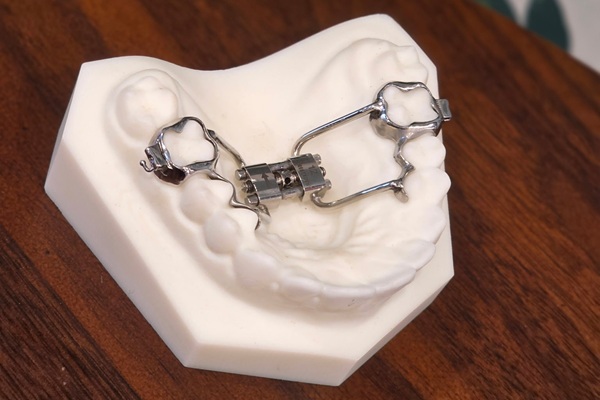How Palate Expanders Work

A palate expander palate expander is a specialized orthodontic device used to widen the upper jaw, creating more space in the mouth and improving overall bite alignment. By gradually separating the two halves of the palate, an expander will help guide proper facial and dental development, especially in children and adolescents whose bones are still growing.
Why palatal expansion may be needed
Palatal expansion becomes necessary when the upper jaw is too narrow to accommodate the lower jaw or when there is significant crowding of the teeth. A narrow upper arch can also lead to crossbites, breathing difficulties, and speech issues. By increasing the width of the upper jaw, a palate expander, also referred to as a rapid maxillary expander (“RME”) or rapid palatal expander (“RPE”), helps ensure proper alignment and function of the teeth and jaws.
How an expander works
The device itself typically consists of two halves that are attached to the upper molars and connected in the center by a small screw mechanism. Each day, the patient or their guardian turns the screw slightly using a special key, which very gradually pushes the halves of the jaw apart. As the device expands, new bone fills in the gap, making the expansion permanent over time. The process is usually painless, although some patients will experience very mild pressure or discomfort during activation.
Who benefits most from a palate expander?
A palate expander, or RME, is most effective in patients under the age of 14, as the bones in the upper jaw are still pliable and not yet fully fused. As you age, the bones on the roof of the mouth solidify, making expansion much more difficult to obtain. However, adult patients may also benefit from expansion when combined with other orthodontic or surgical interventions. While treatment duration varies depending on the degree of expansion, active expansion typically lasts 4-6 weeks. However, the expander remains in place after the active expansion phase to allow the bones to stabilize.
Benefits of palatal expansion
Palatal expansion provides both immediate and long-term benefits, supporting healthier oral development and improved function.
- Improved alignment of the upper and lower teeth
- Reduced crowding and the need for tooth extractions
- Enhanced nasal airflow and breathing
- Prevention of impacted teeth
In some cases, a palate expander may be the first phase of a comprehensive orthodontic treatment plan. After achieving the desired expansion and stabilizing the jaw, traditional braces or clear aligners can straighten the teeth further and refine the bite.
Care and maintenance
It is important to follow care instructions closely during treatment. Expanders must be kept clean to avoid plaque buildup and irritation of the soft tissues. Regular checkups allow the orthodontist to monitor progress and make necessary adjustments. Eating softer foods and avoiding sticky or hard items can also help prevent damage to the expander.
Creating a foundation for a healthy smile
The use of a palate expander plays a critical role in guiding proper dental and facial development. It not only improves function and comfort but also contributes to long-term oral health. Early evaluation by an orthodontist can determine whether palatal expansion is appropriate and when to begin treatment. The American Association of Orthodontists recommend that children be evaluated by a board-certified orthodontist between the ages of 7 and 8. That does not necessarily mean they are ready for treatment, but early interceptive treatment can be critical for fixing issues such as major bite discrepancies, severe crowding, crossbites, and more. If children are not yet ready for treatment, they will join the Anchored Orthodontics Growth & Development program, where we will monitor their dental development every 6-12 months, depending on the patient's needs (all Growth & Development visits are complimentary at Anchored Orthodontics).
By correcting structural imbalances in the jaw, a palate expander creates a foundation for a healthier and more stable smile. This proactive approach often minimizes the need for more invasive procedures later and supports both aesthetic and functional outcomes. For more information or to schedule a complimentary consultation, call Anchored Orthodontics at (612) 200-0020
Directly schedule or request a free consultation here: https://anchoredorthodontics.com or call Anchored Orthodontics at (612) 200-0020 for an appointment in our Minnetonka office.
Check out what others are saying about our services on Yelp: Palate Expander in Minnetonka, MN.
Related Posts
Choosing between clear aligners and clear braces can feel overwhelming to some when exploring orthodontic care. While clear braces and aligners both straighten teeth and align bites, they differ in design, maintenance, and treatment scope. Understanding how each treatment option works will help patients make informed choices on their orthodontic care.Clear aligners are plastic trays…
There are several myths and misconceptions about orthodontics. This is the process of correcting teeth alignment issues using appliances like clear alignments and metal braces. Treatment with orthodontics sometimes also leads to improvements in a person’s facial structure and appearance.Misaligned teeth can ruin how a smile looks and can also increase the risk of issues…
Orthodontics typically involves wearing oral appliances like braces or clear aligners in order to straighten teeth. These devices work by constantly pushing on the wearer’s teeth, moving them to more desirable positions over time. Teeth misalignment can lead to a less aesthetically pleasing smile and a variety of oral issues, like gum disease. Getting appropriate…
Phase Two orthodontics is the the second stage in comprehensive orthodontic treatment, typically following an initial intervention often referred to as Phase One orthodontics. The primary objective of Phase Two orthodontics involves perfecting alignment, correcting any remaining bite issues, and achieving optimal aesthetics and function once a patient has reached full adult dentition. Patients often…





